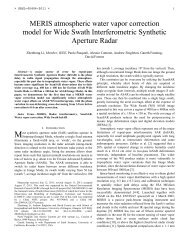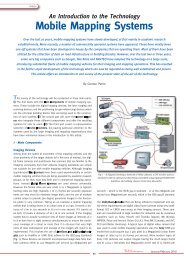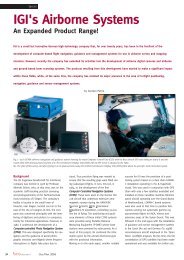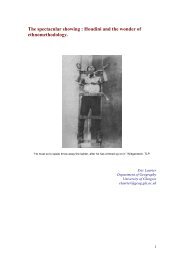Café Ethnography : the uses of tables and chairs
Café Ethnography : the uses of tables and chairs
Café Ethnography : the uses of tables and chairs
Create successful ePaper yourself
Turn your PDF publications into a flip-book with our unique Google optimized e-Paper software.
<strong>Café</strong> <strong>Ethnography</strong>:<br />
customers per table. If <strong>the</strong> sign's rule is followed <strong>the</strong>n during busy periods <strong>the</strong> <strong>tables</strong><br />
need never lie empty, <strong>and</strong> thus unavailable for eating or drinking at, due to a queuing<br />
customer having deposited <strong>the</strong>ir bag or coat on <strong>the</strong> seat to 'reserve' a table. For <strong>the</strong><br />
customers <strong>the</strong> sign indicates <strong>the</strong> correct conduct <strong>the</strong>y should adopt during a busy<br />
period to fit in with <strong>the</strong> ways things are done at <strong>the</strong> Flaming Cup. Of course <strong>the</strong><br />
Flaming Cup's request is not a highly idiosyncratic or unusual way <strong>of</strong> getting <strong>the</strong><br />
business <strong>of</strong> a café done; customers are familiar with such requests in o<strong>the</strong>r cafes <strong>and</strong><br />
are unlikely to be confused or angered by it (‘what <strong>the</strong> hell do <strong>the</strong>y mean, queue first<br />
<strong>the</strong>n take a table!’). Thus, though barely requiring more than a moment's registering,<br />
<strong>the</strong> ink-on-pink sign frames <strong>the</strong> entrance to <strong>the</strong> Flaming Cup as a cheap <strong>and</strong> inclusive<br />
place to dine since it is those kinds <strong>of</strong> places which write <strong>and</strong> post <strong>the</strong>ir rules in such a<br />
way <strong>and</strong> in your way. 9<br />
In <strong>the</strong>ir ethnomethodological analysis <strong>of</strong> queuing Lee <strong>and</strong> Watson (Lee <strong>and</strong> Watson<br />
1993) tease out <strong>the</strong> ‘minimum adequate organisational form for <strong>the</strong> establishing <strong>of</strong><br />
turn order, direction etc.’ (p46). Unlike many analyses <strong>of</strong> <strong>the</strong> organisation <strong>of</strong> space<br />
<strong>the</strong>ir attention to <strong>the</strong> fine details <strong>and</strong> ordinary underst<strong>and</strong>ings <strong>of</strong> <strong>the</strong> members actually<br />
doing <strong>the</strong> queuing picks out, amongst o<strong>the</strong>r aspects, <strong>the</strong> dynamic features <strong>of</strong> <strong>the</strong><br />
queue. They show how <strong>the</strong> queue although apparently having static categories (such<br />
as head <strong>of</strong> <strong>the</strong> queue, second in <strong>the</strong> queue, tail end <strong>of</strong> <strong>the</strong> queue) never<strong>the</strong>less moves<br />
members through its order from one category to <strong>the</strong> next. Each member <strong>of</strong> a queue<br />
has a ‘moral requirement’ to be aware <strong>of</strong> <strong>the</strong>ir changing place in <strong>the</strong> order <strong>of</strong> <strong>the</strong><br />
queue <strong>and</strong> to take <strong>the</strong>ir turn promptly or <strong>the</strong>y will be susceptible to justified<br />
complaints from people fur<strong>the</strong>r down <strong>the</strong> line. What we are looking at is some <strong>of</strong> <strong>the</strong><br />
spacing <strong>of</strong> organisation <strong>and</strong> organising <strong>of</strong> space that lies before <strong>and</strong> after <strong>the</strong> queuing<br />
sequence in our café. The doorway with its sign thus provides a sequential order to<br />
<strong>the</strong> space which customers are about to enter (<strong>and</strong> by entering through door with its<br />
audible creaking hinge <strong>and</strong> tinkling bell <strong>the</strong>y are immediately placed into <strong>the</strong> category<br />
‘c<strong>and</strong>idate customer’). The sequential order as we summarise it, though it can be<br />
decomposed into smaller units 10 is:<br />
1. Join <strong>the</strong> queue<br />
2. Take a seat<br />
However <strong>the</strong>re are many ‘tactics’ (De Certeau 1984) customers utilise to get around<br />
<strong>the</strong> {queue-first, seat-second} rule such as by simply ignoring it <strong>and</strong> reserving seats<br />
with an item such as a coat or a bag. And it is worth bearing in mind that if enough<br />
customers tactically ignore <strong>the</strong> text-on-<strong>the</strong>-door <strong>the</strong>n it will no longer be seen as a<br />
relevant rule once inside <strong>the</strong> café, it would clearly be a sign that everyone ignores.<br />
Also <strong>the</strong>re are customers who its rule fails to apply to who are picking up take-away<br />
food, yet <strong>the</strong>ir display <strong>of</strong> queuing assists in <strong>the</strong> apparent observance <strong>of</strong> <strong>the</strong> rule.<br />
Additionally <strong>the</strong>y are clearly not breaking <strong>the</strong> rule by not taking a seat. They are able<br />
to see in <strong>the</strong> writing on <strong>the</strong> pink card <strong>the</strong> members to whom <strong>the</strong> rule applies.<br />
9 In contrast, for instance, to <strong>the</strong> bye-laws posted at <strong>the</strong> entrance to <strong>the</strong> neighbourhood park which are<br />
lengthy, numbered from 1-15, type-written, laminated, observed by accident <strong>and</strong> seldom enforced. Or<br />
to <strong>the</strong> street sign outside <strong>the</strong> Flaming Cup which lists <strong>the</strong> parking restrictions which is read very<br />
carefully by people parking <strong>the</strong>re <strong>and</strong> frequently enforced by parking wardens.<br />
10 See (Lee <strong>and</strong> Watson 1993) for <strong>the</strong>ir breakdown <strong>of</strong> <strong>the</strong> queue into its minimal units.<br />
10
















